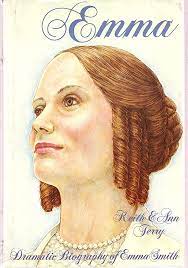Articles/Essays – Volume 14, No. 1
Cheap Shots Miss the Mark | Keith and Ann Terry, Emma: The Dramatic Biography of Emma Smith
Be advised: a biography that thanks “team members” for accommodating “impossible scheduling” just might be thrown together hastily. And in spite of an attempt to lend an aura of authenticity to the book by acknowledging the research assistance of “three Brigham Young University graduate students and a Harvard graduate with a Ph.D. from Claremont”—all mercifully unnamed— the bias of the authors is immediately established. “We experienced shock, disbelief, at times something close to hatred. Continuing, we felt pity, empathy, kinship, disappointment, and ultimately a sorrowful love, tempered by tender understanding.” If what Keith and Ann Terry have done for Emma Smith is exhibit tender understanding, God grant that I may never be subjected to it.
Perhaps the Terrys unwittingly set the tone of inaccuracy and insinuation when they used Heber C. Kimball’s angry 1857 statement about Emma in the “Preface” without explanation: “Joseph stood for the truth and maintained it, she struck against it, and where is she? She is where she is, and she will not escape until Joseph Smith opens the door and lets her out.” Contrary to being condemned to hell as the statement implied, Emma was alive and well in Nauvoo, married to a decent man whom she loved, and was happily awaiting the birth of her first grandchild.
Two outstanding flaws exist throughout the book. First, Emma is continually judged to be wrong, weak, evil, sniveling, or lacking in faith, and such judgements are based on wholly inaccurate and incomplete information. “There must exist more material than we have seen,” the authors concede, “in private collections and in the keeping of the Reorganized Latter Day Saints Church. When it is made available. … ” The implication that the RLDS church archives are not open to researchers is absurd. No attempt to recreate the life of Emma Smith can be made without using that extensive collection of material relating to her. Few sources in the book are primary; thus the book could be none other than a rehash of all the old apocryphal stories that have circulated for years about Emma. To fill in the obvious gaps the pages are replete with the verb form “must have,” as in “words must have sent jolts of fear coursing through” her, or “how sorely Emma’s conscience must have plagued her.” Such banality obscures her personality.
The second flaw is that the authors are unable to illustrate Emma and Joseph’s relationship. Their marriage appears shallow; nowhere does the reader sense the implacable frustrations, the powerful partnership, or the deep love that existed between these two. After a one sentence introduction to’ polygamy that stated, “Joseph Smith was taking to himself other wives/’ and teaching other men to do the same, the authors have Emma boarding a steamboat to St. Louis; “Emma’s whole being must have been afire with the turmoil of polygamy.” Period. No explanation is given that Emma had struggled with rumors and innuendo surrounding her husband’s participation in plural marriage from the time he had instituted the practice twelve years earlier. The Terrys picture Emma attacking polygamy “with her flashing eyes and determined will” and conclude without any evidence that Emma did not ever pray about the subject. They attempt to use Doctrine and Covenants section 132 to establish that Emma was told by the Lord that she would be destroyed if she did not accept her husband’s plural wives. Not so. If the Terrys are going to turn to scripture to support an accusation, they cannot fabricate artificial theological statements by grafting the first part of verse fifty-two to the last part of verse fifty-four. My reading of that last verse tells me that Emma is commanded to “abide and cleave” to Joseph or else “be destroyed.” Though their relationship became very strained over polygamy, Joseph’s letter to Emma, written the morning of his death, establishes that she was still his companion, confidant and supporter to the end. In one of the most unfair comparisons in Mormon history, they contrast Emma and her “churning mind” to Mary, the mother of Christ. A cheap shot.
A second cheap shot is taken when Emma is accused of convincing Joseph to come back across the river when he and Hyrum were ready to flee Nauvoo before the martyrdom. My research indicates that two land speculators in Nauvoo used Emma as a scapegoat in an attempt to salvage their interests in Nauvoo real estate. These kinds of historical inaccuracies fill the volume. Joseph did not escape from Kirtland in a box nailed on an oxcart; Porter Rockwell was in jail in 1843, not operating a bar in the Mansion House; Emma made two trips to St. Louis; the argument between Emma and the Twelve after Joseph’s death did not consist solely of Emma making a “raid on all Church properties;” and so forth. While this volume introduces the reader to little known events in the life of Emma Smith, one purpose for historical writing is to illuminate the past in order for the present to understand. It hasn’t been done here.
Emma: The Dramatic Biography of Emma Smith by Keith and Ann Terry. Santa Barbara, California: Butterfly Publishing, Inc., 1979. 160 pp. $6.95.


 Back to full Issue
Back to full Issue

